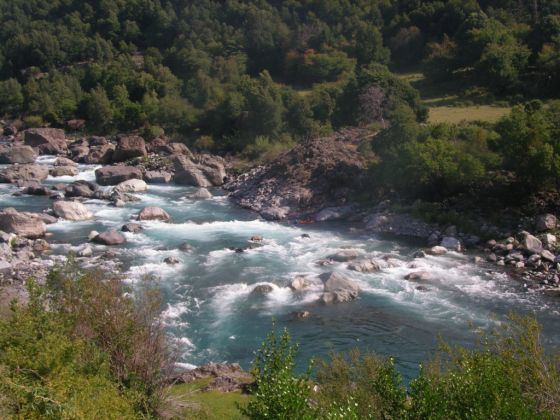Country Chile Time zone CLT (UTC-4) Website Government of Ñuble Capital Chillán | Region Bío Bío Area code(s) 56 + 42 Area 13,178 km² Team Ñublense | |
 | ||
University Universidad Adventista De Chile Points of interest St Charles Borromeo Cathedral, Quirel Park, Salto del Itata, Museo Claudio Arrau, Estación de Ferrocarri Destinations Chillán, Quillón, Yungay - Chile, Cobquecura, San Fabián | ||
Ñuble Province (Spanish: Provincia de Ñuble) is one of four provinces of the Chilean region of Bío Bío (VIII). It spans an area of 13,178.5 km2 (5,088 sq mi) and is administratively constituted by 21 communes. It has a population of 441,604 inhabitants. Its capital is the city of Chillán.
Contents
- Map of C391uble Province BiobC3ADo Chile
- History
- Geography and demography
- Culture and tourism
- Administration
- Communes
- Itata Valley wine region
- Grape distribution by varietal
- References
Map of %C3%91uble Province, Biob%C3%ADo, Chile
History
The province was created in 1848 with the San Carlos Department of Maule Province and Chillán Department of Concepción Province. In 1884, the departments of Bulnes and Yungay, were created from the Chillán Department. In 1927, the provincial limits were modified and the Itata Department was added from Maule. Later, in 1976, the communes of Coelemu and Ránquil from Concepción Province, and the commune of Tucapel from Bío Bío Province, were added.
Following the 8.8 magnitude earthquake and tsunami, at least eight small communities and two towns were abandoned by residents, who took up makeshift camps in the hills, fearful of further tsunamis. Over 800 residences in the town of Quirihue were destroyed, leaving little for townspeople to return to.
Geography and demography
According to the 2002 census by the National Statistics Institute (INE), the province spans an area of 13,178.5 km2 (5,088 sq mi) and had a population of 438,103 inhabitants (217,024 men and 221,079 women), giving it a population density of 33.2/km2 (86/sq mi). It is the seventh most populated province in the country. Of these, 285,108 (65.1%) lived in urban areas and 152,995 (34.9%) in rural areas. Between the 1992 and 2002 censuses, the population grew by 4.5% (18,854 persons).
Culture and tourism
Ñuble has a lot of attractions for tourists, including:
Other places of interest are the Market and Fair of Chillán, one of the more beautiful and important artisan centers of Chile. Murals by Siqueiros were donated by the Government of Mexico. There is also Bernardo O'Higgins Monumental Park in the locality of Old Chillán.
Among the activities characteristic of Ñuble are crafts, in particular in the localities of Quinchamalí (considered like one of the country's more important places of artisan production of white clay pottery), Coihueco (characterized by the wood carvings and loom weaving), Ninhue and San Fabián de Alico.
In recent years the province of Ñuble has consolidated an important forest sector, thanks to favorable climatic conditions land for the development of plantations of such rapidly growing trees as pinus radiata and eucalyptus globulus.
Ñuble has a variety of celebrations and events. Outstanding among these are the Rodeo, a celebration huasa that takes place between September and February. The Agro-Expo of San Carlos is an agricultural, cattle and artisan exhibition, with strong accent on dairying.
The province has the pride of being the home of patriots, artists and other men of note, including, Bernardo O'Higgins, Arturo Prat, Claudio Arrau, Ramón Vinay, and Violeta Parra.
Chillán, the capital of Ñuble, may be reached by the following routes:
Administration
As a province, Ñuble is a second-level administrative division of Chile, governed by a provincial governor who is appointed by the president.
Communes
The province comprises 21 communes, each governed by a municipality consisting of an elected alcalde and municipal council.
Itata Valley wine region
The Itata Valley is a wine region in southern Chile and a Denomination of Origin (DO) is defined by the Chilean Appellation system, the legally defined and protected geographical indication used to identify where the grapes for a wine were grown. The valley is located in the province of Ñuble, 420 kilometres (250 mi) from Santiago, the capital of Chile, and 65 kilometres (40 mi) of the major port of Concepción. It is the northernmost of Chile’s three southern wine regions and stretches roughly 60 miles (100 km) from north to south and a similar distance from east to west, but although it is extensive, it has a low density of vineyard plantations. The area is defined by the convergence of the Itata and Ñuble Rivers, and vineyards plantations are mostly found around the towns of Chillan, Quillon and Coelemu. The valley’s western border is the Pacific Ocean, which has a cooling influence over the valley due the cold Humboldt current that runs along most of Chile’s coastline. The cool Mediterranean climate suits Pais, Muscat of Alexandria and Carignan vines, and more recently, producers have begun to plant more modern grape varieties like Cabernet Sauvignon.
The soils are alluvial, made up of sand and clay from the Itata and Ñuble rivers. The region is located at a latitude of 36°S, a similar distance from the Equator as southern Spain or the central valley of California.
Grape distribution by varietal
Total hectares planted: 636 ha (1,572 acres).
